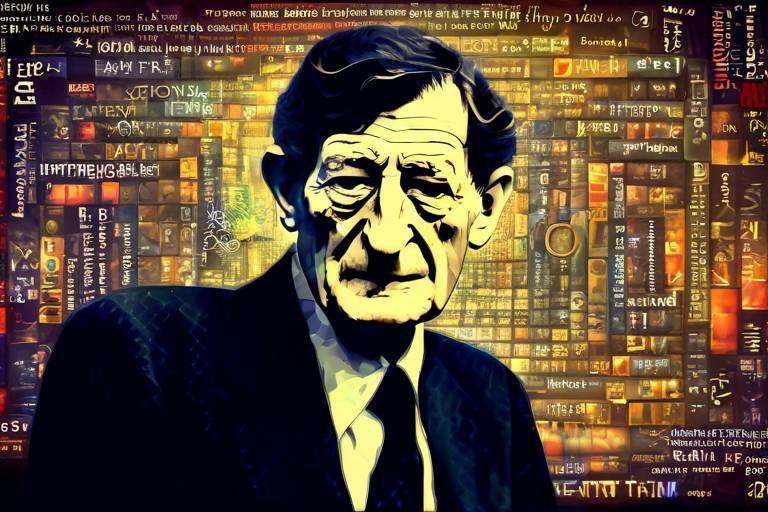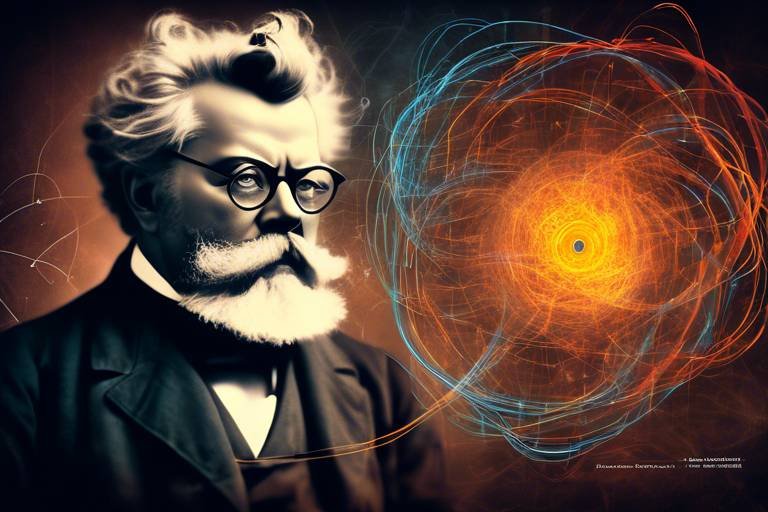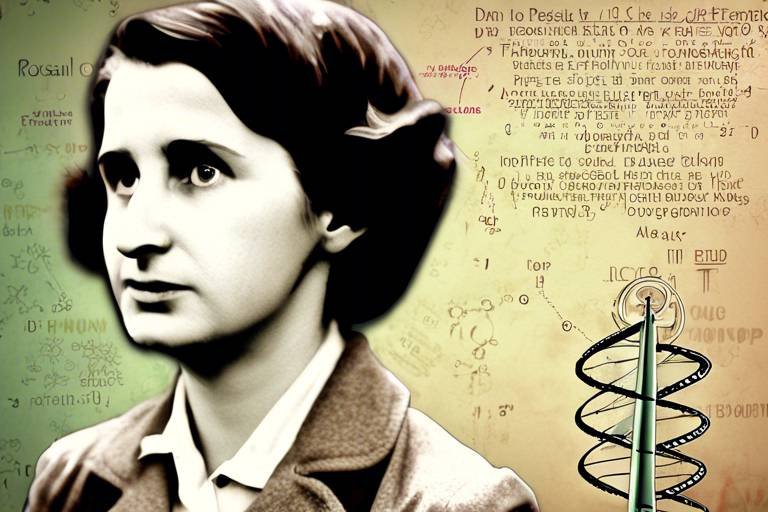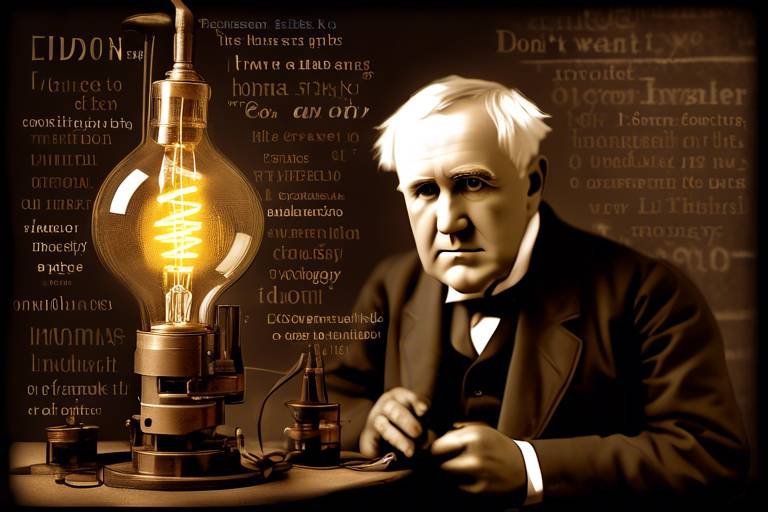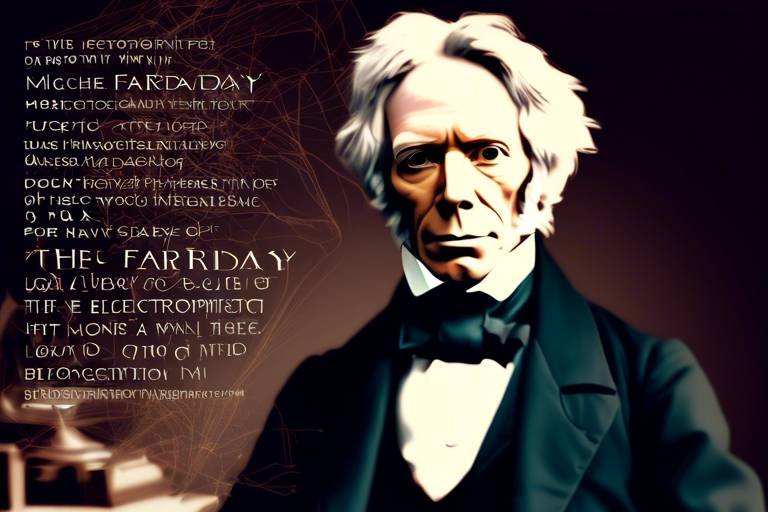The Discoveries of James Clerk Maxwell in Electromagnetism
When we think about the heroes of physics, names like Einstein and Newton often steal the spotlight. However, lurking in the shadows of these giants is a man whose work was pivotal in shaping our understanding of the universe: James Clerk Maxwell. His contributions to the field of electromagnetism were nothing short of revolutionary, laying the groundwork for countless technological advancements that we now take for granted. Imagine a world without electricity or wireless communication; it’s hard to fathom, right? Maxwell’s theories not only bridged the gap between electricity and magnetism but also opened the door to modern physics as we know it today.
Maxwell was not just a scientist; he was a visionary who synthesized the work of his predecessors, turning disjointed concepts into a coherent theory. His most notable achievement, the formulation of Maxwell's Equations, is a set of four equations that elegantly describe how electric and magnetic fields interact. These equations are the backbone of classical electromagnetism, and they reveal the profound connection between light, electricity, and magnetism. In a sense, Maxwell painted a picture of the invisible forces that govern our world, and his brushstrokes have had lasting effects on both science and technology.
But what exactly did Maxwell discover? His groundbreaking work can be boiled down to a few key themes. First, he established that electric and magnetic fields are interrelated and can influence each other. Second, he introduced the concept of the electromagnetic wave, suggesting that light itself is an electromagnetic phenomenon. This was a paradigm shift that changed the way scientists viewed the universe. Imagine the astonishment of his contemporaries when they realized that light, a phenomenon they had studied for centuries, was intricately tied to electricity and magnetism!
In the following sections, we will delve deeper into the specifics of Maxwell's equations, explore their implications for modern physics, and uncover how his theories have paved the way for the technologies we rely on today. So, buckle up and get ready to journey through the fascinating world of electromagnetism, where the invisible becomes visible and the ordinary transforms into the extraordinary!
Maxwell's early work laid the foundation for electromagnetic theory, synthesizing previous research and establishing a coherent framework that linked electricity and magnetism, ultimately leading to the formulation of his famous equations.
Maxwell's equations are a set of four fundamental equations that describe how electric and magnetic fields interact. This section delves into each equation's significance and implications for modern physics.
Gauss's Law describes the relationship between electric charge and electric field. This subheading discusses its importance in understanding electric fields generated by static charges.
Gauss's Law for Magnetism states that there are no magnetic monopoles. This section explores how this principle shapes our understanding of magnetic fields and their behavior.
Faraday's Law of Induction explains how a changing magnetic field can induce an electric current. This subheading examines its applications in electrical engineering and technology.
The Ampère-Maxwell Law extends Ampère's original work by incorporating the concept of displacement current. This section illustrates its role in the propagation of electromagnetic waves.
Maxwell's discoveries revolutionized physics, paving the way for future developments in quantum mechanics and relativity. This section highlights how his work influenced subsequent scientific advancements.
Maxwell's equations are the foundation for many modern technologies, including telecommunications and electrical engineering. This section explores the practical applications that stem from his groundbreaking theories.
James Clerk Maxwell's contributions to electromagnetism have earned him a revered place in scientific history. This subheading discusses his legacy and the recognition he received during and after his lifetime.
- What are Maxwell's Equations? Maxwell's Equations are four fundamental equations that describe how electric and magnetic fields interact and propagate through space.
- Why are Maxwell's contributions important? Maxwell's work laid the foundation for modern physics, influencing fields such as quantum mechanics, relativity, and electrical engineering.
- How did Maxwell's work impact technology? His theories are fundamental to the development of technologies such as radio, television, and wireless communication.

The Birth of Electromagnetic Theory
James Clerk Maxwell was a true pioneer in the realm of physics, and his **incredible insights** into electromagnetism laid the groundwork for what we now understand as **electromagnetic theory**. Before Maxwell, scientists like **Michael Faraday** and **Anders Jonas Ångström** had already made significant strides in understanding electricity and magnetism. However, Maxwell was the one who managed to synthesize these earlier discoveries into a cohesive framework that connected the two fields. Imagine trying to piece together a complex puzzle; that's precisely what Maxwell did, and his work was nothing short of revolutionary.
Maxwell's journey into the world of electromagnetism began with his fascination for the **forces of nature**. He sought to answer questions that had puzzled scientists for centuries: How do electric fields interact with magnetic fields? What are the underlying principles governing these forces? By meticulously studying the works of his predecessors, Maxwell began to formulate his own theories, eventually leading to the creation of what we now refer to as **Maxwell's Equations**. These equations not only describe the behavior of electric and magnetic fields but also illustrate the **interconnectedness of these forces**.
To understand the significance of Maxwell's contributions, one must appreciate the context in which he worked. During the 19th century, the scientific community was buzzing with discoveries in electricity and magnetism. The ability to generate electricity was becoming more practical, and the potential for harnessing these forces was **captivating**. Maxwell's work acted as a bridge, connecting these disparate ideas and bringing clarity to the chaotic landscape of electromagnetic phenomena.
In essence, Maxwell's electromagnetic theory can be viewed as a **masterful symphony** where each instrument plays a crucial role in creating a harmonious whole. The **melody** of electricity and magnetism was finally unified, allowing for the development of technologies that would change the world forever. Without Maxwell's contributions, we might not have the **telecommunications**, **electric motors**, or even the **internet** that we take for granted today.
Moreover, Maxwell's equations provided a mathematical foundation that future scientists could build upon. They opened the door to new fields of study, including **quantum mechanics** and **relativity**. It's fascinating to think that a single individual's work could ripple through time, influencing generations of scientists and engineers.
In summary, the birth of electromagnetic theory is a tale of curiosity, innovation, and the relentless pursuit of knowledge. James Clerk Maxwell's ability to synthesize existing ideas into a comprehensive framework not only changed the course of physics but also laid the groundwork for the technological advancements we enjoy today. His legacy continues to inspire scientists and researchers as they delve deeper into the mysteries of the universe.

Maxwell's Equations Explained
Have you ever wondered how electricity and magnetism are intertwined in our everyday lives? Well, the magic behind this connection lies in the brilliant mind of James Clerk Maxwell, who formulated a set of equations that revolutionized our understanding of electromagnetism. Maxwell's equations are not just a collection of mathematical expressions; they are the very foundation of classical electromagnetism, optics, and even electrical engineering. Let’s dive into these four fundamental equations and uncover their significance and implications for modern physics.
The first equation, known as Gauss's Law, establishes a direct relationship between electric charge and the electric field it generates. Imagine you have a balloon that you’ve rubbed against your hair; it becomes charged, creating an electric field around it. Gauss's Law mathematically expresses how the total electric flux through a closed surface is proportional to the charge enclosed within that surface. This principle is crucial for understanding phenomena such as electric fields created by static charges. It allows engineers and scientists to predict how charges will behave in various configurations, which is vital for designing electrical circuits and devices.
Next up, we have Gauss's Law for Magnetism. This equation tells us something quite fascinating: there are no magnetic monopoles. In simpler terms, every magnet has both a north and a south pole. You can think of it like a pizza; no matter how you slice it, you’ll always have two equal halves. This law helps us understand that magnetic field lines are continuous loops, which is fundamental to the behavior of magnets and electromagnetic devices. The absence of magnetic monopoles also has profound implications for our understanding of magnetic fields in nature.
Moving on, we encounter Faraday's Law of Induction. This law explains a remarkable phenomenon: a changing magnetic field can induce an electric current. Picture this: when you move a magnet through a coil of wire, it creates electricity! This principle is the backbone of many technologies we rely on today, such as electric generators and transformers. Faraday's Law has made it possible to convert mechanical energy into electrical energy, fundamentally altering how we generate and use power in our daily lives.
Finally, we arrive at the Ampère-Maxwell Law. This equation extends the original work of André-Marie Ampère by introducing the concept of displacement current, which accounts for changing electric fields. It’s like adding a new ingredient to a recipe that enhances the flavor! This law is essential for understanding how electromagnetic waves propagate through space, which is critical for technologies such as radio, television, and even Wi-Fi. Without this equation, our ability to communicate wirelessly would not exist.
In summary, Maxwell's equations are a powerful set of tools that describe the interactions of electric and magnetic fields. They provide a comprehensive framework for understanding not just the behavior of electricity and magnetism, but also how these forces shape the world around us. From powering our homes to enabling global communications, the impact of Maxwell's work is truly monumental.
- What are Maxwell's equations? They are four fundamental equations that describe how electric and magnetic fields interact.
- Why are Maxwell's equations important? They form the foundation of classical electromagnetism and are crucial for understanding many modern technologies.
- How do Maxwell's equations relate to everyday life? They explain the principles behind electricity, magnetism, and electromagnetic waves, which are integral to daily technologies.

The First Equation: Gauss's Law
Gauss's Law is a cornerstone of electromagnetism that provides a vital link between electric charge and the electric field it generates. At its core, this law states that the total electric flux through a closed surface is directly proportional to the enclosed electric charge. In simpler terms, if you imagine a balloon filled with air, the amount of air inside (representing electric charge) determines the pressure on the surface of the balloon (representing the electric field). This relationship is not just a neat analogy; it forms the basis for understanding how electric fields behave around charged objects.
To visualize Gauss's Law, picture a sphere surrounding a charged object. The electric field lines radiate outwards from the charge, and the total number of lines passing through the surface of the sphere is proportional to the amount of charge inside. This concept allows physicists to calculate electric fields in situations where symmetry simplifies the math, like with spherical or cylindrical charge distributions. It's a powerful tool that makes complex calculations much more manageable.
Mathematically, Gauss's Law is expressed as:
∮ E · dA Q_enc / ε₀
In this equation, E represents the electric field, dA is an infinitesimal area on the closed surface, Q_enc is the enclosed charge, and ε₀ is the vacuum permittivity constant. This equation is not just a formula; it encapsulates a profound understanding of how charges interact with their surroundings.
Understanding Gauss's Law is crucial for various applications, especially in fields like electrical engineering and physics. For instance, it allows engineers to design capacitors and other electronic components with precision. By knowing how charges distribute themselves, they can optimize devices to store and manipulate electrical energy efficiently.
Moreover, Gauss's Law also plays a pivotal role in understanding electrostatics, which is the study of electric charges at rest. It helps in explaining phenomena such as how charged objects influence each other and how electric fields can be shielded. This principle is essential for developing technologies like electrostatic precipitators used in pollution control.
In summary, Gauss's Law is not just a theoretical concept; it's a practical tool that has far-reaching implications in science and technology. By bridging the gap between charge and electric fields, it lays the groundwork for further exploration into the complexities of electromagnetism and its applications in our daily lives.
- What is Gauss's Law? Gauss's Law states that the total electric flux through a closed surface is proportional to the enclosed electric charge.
- How is Gauss's Law applied in real life? It is used in designing capacitors, understanding electrostatics, and in technologies like electrostatic precipitators.
- What does the equation for Gauss's Law represent? The equation relates the electric field to the charge enclosed by a surface, helping to calculate electric fields in various scenarios.

The Second Equation: Gauss's Law for Magnetism
Gauss's Law for Magnetism is a cornerstone of electromagnetic theory, encapsulating a profound truth about the nature of magnetic fields. In essence, it states that the total magnetic flux through a closed surface is always zero. This implies that magnetic monopoles—hypothetical singular magnetic charges—do not exist. Instead, every magnet has both a north and a south pole, and these poles cannot be isolated. Imagine trying to find just one side of a pair of scissors; you simply can't, as both sides are inherently linked. This principle reshapes our understanding of magnetism, emphasizing that magnetic field lines always form closed loops.
To further illustrate this concept, consider the following points:
- Magnetic Field Lines: They originate from the north pole of a magnet and terminate at the south pole, creating a continuous loop.
- Field Strength: The intensity of the magnetic field diminishes with distance from the source, similar to how a sound fades as you move away from a speaker.
- Applications: This law is crucial in understanding not just static magnets but also dynamic systems like electric motors and generators, where magnetic fields play a vital role.
Mathematically, Gauss's Law for Magnetism can be expressed as:
∮ B · dA 0
In this equation, the integral of the magnetic field (B) over a closed surface (dA) results in zero, reinforcing the idea that magnetic field lines do not begin or end at any point in space. Instead, they perpetually loop back on themselves. This insight is not just a theoretical curiosity; it has practical implications in various fields, including electrical engineering and physics. For instance, understanding how magnetic fields behave is essential for designing efficient transformers and inductors.
Moreover, Gauss's Law for Magnetism has paved the way for further explorations in theoretical physics. It lays the groundwork for concepts such as electromagnetic waves, which are fundamental to technologies like radio, television, and wireless communications. Without this understanding, the modern world would look vastly different, lacking the conveniences we often take for granted.
In summary, Gauss's Law for Magnetism is not just an abstract principle; it is a vital part of the electromagnetic framework that governs our universe. By acknowledging the interconnected nature of magnetic fields, we can appreciate the elegance and complexity of the physical world around us.

The Third Equation: Faraday's Law of Induction
Faraday's Law of Induction is a cornerstone of electromagnetism, illustrating the profound relationship between electricity and magnetism. Simply put, this law states that a changing magnetic field within a closed loop induces an electric current in that loop. Imagine it like a dance: the magnetic field moves and sways, and in response, the electric current twirls to life, creating a beautiful interplay of forces. This phenomenon is not just theoretical; it's the very foundation of many technologies we rely on today.
To grasp the significance of Faraday's Law, consider the following key points:
- Induction in Action: When a magnet is moved toward a coil of wire, the magnetic field through the coil changes, inducing a current. This principle is harnessed in generators, where mechanical energy is converted into electrical energy.
- Applications in Technology: Faraday's Law is pivotal in the functioning of transformers, inductors, and various electrical devices, making it indispensable in electrical engineering.
- Real-World Examples: From the simple act of turning on a flashlight to the complex operations of power plants, Faraday's Law is at work, demonstrating its universal applicability.
One fascinating application of Faraday’s Law is in wireless charging. This technology uses electromagnetic induction to transfer energy between two coils—one in the charger and the other in the device being charged. As the magnetic field oscillates, it induces a current in the receiving coil, powering up your gadgets without the hassle of wires. This innovation is just one example of how Faraday's insights have permeated modern life.
Faraday’s Law also has profound implications in the realm of renewable energy. Wind turbines, for instance, rely on this principle to convert kinetic energy from wind into electrical energy. As the blades turn, they alter the magnetic field around a coil, generating electricity that can power homes and businesses. This not only showcases the practical applications of Faraday's Law but also highlights its role in advancing sustainable energy solutions.
In summary, Faraday's Law of Induction is more than just an equation; it is a vital concept that bridges the gap between theoretical physics and practical technology. Its ability to describe how electric currents can be generated through changing magnetic fields has led to countless innovations and continues to inspire new advancements in science and engineering.
- What is Faraday's Law of Induction?
Faraday's Law states that a change in the magnetic environment of a coil of wire will induce a voltage in the coil. - How is Faraday's Law applied in real life?
It is used in various applications, including electrical generators, transformers, and wireless charging technologies. - Why is Faraday's Law important?
It is fundamental to understanding electromagnetism and has paved the way for technological advancements in electricity generation and transmission.

The Fourth Equation: Ampère-Maxwell Law
The **Ampère-Maxwell Law** is a pivotal equation in the realm of electromagnetism, extending the insights of André-Marie Ampère by incorporating the concept of **displacement current**. This law provides a comprehensive understanding of how electric currents and changing electric fields work together to generate magnetic fields. In simpler terms, it tells us that not only does a moving electric charge create a magnetic field, but a changing electric field can also do the same. This is a revolutionary idea that reshaped our understanding of electromagnetism.
To break it down further, the Ampère-Maxwell Law can be expressed mathematically as:
∇ × **B** μ₀ **J** + μ₀ε₀(∂**E**/∂t)
Here, **B** represents the magnetic field, **J** is the current density, **E** is the electric field, μ₀ is the permeability of free space, and ε₀ is the permittivity of free space. The term μ₀ε₀(∂**E**/∂t) is what we refer to as the displacement current, and it plays a crucial role in understanding electromagnetic wave propagation.
Imagine a calm lake. When you throw a stone into it, ripples spread out in concentric circles. In a similar way, when an electric field changes, it creates ripples in the magnetic field. This interaction is fundamental to how electromagnetic waves, such as light, travel through space. The concept of displacement current allows us to account for situations where electric fields change over time, even in the absence of physical currents, thus enabling the propagation of electromagnetic waves.
One of the most exciting applications of the Ampère-Maxwell Law is in the field of **wireless communication**. Without this law, technologies such as radio, television, and mobile phones would not be possible. The ability of electromagnetic waves to travel through the air and carry information is a direct consequence of Maxwell's unification of electricity and magnetism.
Furthermore, the implications of the Ampère-Maxwell Law extend beyond communication. It is also fundamental in designing electrical devices, such as transformers and inductors, which rely on changing magnetic fields to function effectively. The understanding of electromagnetic induction, rooted in this law, has been essential for advancements in **electrical engineering** and **power generation**.
In summary, the Ampère-Maxwell Law is not just an equation; it is a gateway to understanding the intricate dance between electric and magnetic fields. Its significance cannot be overstated, as it lays the groundwork for countless technologies that define our modern world.
- What is the Ampère-Maxwell Law?
The Ampère-Maxwell Law describes how electric currents and changing electric fields generate magnetic fields. It extends Ampère's original work by including displacement current.
- Why is the displacement current important?
The displacement current allows us to understand and predict the behavior of changing electric fields, especially in situations where no physical current flows, enabling the propagation of electromagnetic waves.
- How does the Ampère-Maxwell Law apply to modern technology?
This law is foundational for technologies such as wireless communication, electrical devices like transformers, and various applications in electrical engineering.

The Impact of Maxwell's Work on Physics
James Clerk Maxwell's contributions to the field of physics are nothing short of revolutionary. His work did not merely add to the existing knowledge; it fundamentally transformed our understanding of the universe. Prior to Maxwell, electricity and magnetism were viewed as separate phenomena, like two distant cousins who rarely interacted. However, Maxwell brilliantly connected these two forces, showing that they are, in fact, intertwined in a complex dance. This synthesis laid the groundwork for the modern field of electromagnetism, which is pivotal in many areas of physics.
One of the most significant impacts of Maxwell's work is seen in the development of electromagnetic theory. His equations provided a mathematical framework that describes how electric and magnetic fields interact and propagate through space. This was akin to giving scientists a new pair of glasses, allowing them to see the hidden connections between various physical phenomena. The implications of this were profound, paving the way for advancements in numerous scientific fields including quantum mechanics and relativity.
Maxwell's equations not only shaped theoretical physics but also had practical applications that revolutionized technology. For instance, the principles derived from his work are fundamental to the design of electrical circuits, the functioning of motors, and the operation of transformers. Imagine trying to navigate through a dense fog without a compass; Maxwell's equations served as the guiding light for engineers and scientists venturing into the unknown realms of electrical technology.
Moreover, Maxwell's insights into electromagnetic waves paved the way for the discovery of radio waves and ultimately the development of wireless communication technologies. This leap was akin to discovering a new continent, opening up vast new territories for exploration and innovation, from radio broadcasting to mobile phones. Maxwell’s work created a ripple effect that continues to influence our daily lives, making him a cornerstone of modern physics.
In addition to his direct contributions, Maxwell's legacy is evident in the way he inspired future generations of scientists. His work encouraged others to explore the realms of physics and engineering with a new perspective. For example, the work of Albert Einstein, particularly his theories of special and general relativity, can be traced back to the foundational concepts established by Maxwell. This interconnectedness of scientific ideas highlights how Maxwell's influence extends far beyond his own time, creating a lasting impact that resonates in contemporary physics.
In summary, the impact of Maxwell's work on physics is monumental. By bridging the gap between electricity and magnetism, he not only reshaped theoretical frameworks but also catalyzed technological advancements that have become integral to modern society. Maxwell's legacy lives on, reminding us that the pursuit of knowledge is a collaborative journey, where each discovery builds upon the last.
- What are Maxwell's equations? Maxwell's equations are a set of four fundamental equations that describe how electric and magnetic fields interact and propagate through space.
- How did Maxwell's work influence technology? Maxwell's work laid the foundation for many modern technologies, including telecommunications, electrical engineering, and wireless communication.
- Why are Maxwell's equations important in physics? They provide a comprehensive framework for understanding electromagnetic phenomena, which are crucial for both theoretical and applied physics.
- What is the legacy of James Clerk Maxwell? Maxwell's contributions have inspired generations of scientists and are fundamental to many areas of modern physics, including quantum mechanics and relativity.

Applications of Maxwell's Theories in Technology
James Clerk Maxwell's groundbreaking theories have not only reshaped our understanding of electromagnetism but have also paved the way for numerous technological advancements that define our modern world. From the way we communicate to how we generate power, Maxwell's equations are the backbone of many technologies we often take for granted. Imagine a world without smartphones, radios, or even the internet—it's hard to fathom, right? This is precisely the impact of Maxwell's work on our daily lives.
One of the most significant applications of Maxwell's theories is in the field of telecommunications. The principles outlined in his equations govern the behavior of electromagnetic waves, which are essential for transmitting information over vast distances. Whether it's radio waves broadcasting your favorite music or microwaves enabling your Wi-Fi connection, Maxwell's equations are at play. In fact, the entire framework of modern communication systems relies on the understanding of how these waves propagate through different mediums.
Moreover, Maxwell's work is crucial in the development of electrical engineering. His equations describe how electric and magnetic fields interact, leading to innovations in electric motors and generators. For instance, consider how an electric motor converts electrical energy into mechanical energy—this process is fundamentally rooted in Maxwell's principles. Without his insights, we might still be relying on steam engines instead of the efficient electric motors that power our appliances today.
In addition to telecommunications and electrical engineering, Maxwell's theories have a profound impact on medical technology. Magnetic Resonance Imaging (MRI), a vital tool in modern medicine, operates based on principles derived from electromagnetism. The ability of MRI machines to create detailed images of the body's internal structures relies on the interaction of magnetic fields and radio waves, illustrating yet another application of Maxwell's equations in technology.
The realm of optics also benefits from Maxwell's contributions. The understanding of light as an electromagnetic wave has led to advancements in various optical technologies, including lasers and fiber optics. These technologies are not only used in telecommunications but also in medical procedures and manufacturing processes. It's fascinating to think how a single set of equations can influence such diverse fields!
To summarize, the applications of Maxwell's theories in technology are vast and varied. Here are a few key areas where his work has made a significant impact:
- Telecommunications: Governs the transmission of electromagnetic waves.
- Electrical Engineering: Essential for the design of motors and generators.
- Medical Technology: Underpins MRI and other imaging techniques.
- Optics: Influences the development of lasers and fiber optics.
As we continue to innovate and explore new technologies, it's clear that Maxwell's legacy will endure. His equations not only provide a framework for understanding electromagnetic phenomena but also inspire future generations of scientists and engineers to push the boundaries of what is possible. So, the next time you use your smartphone or undergo an MRI scan, take a moment to appreciate the brilliant mind of James Clerk Maxwell and the lasting impact of his work on our technological landscape.
Q: What are Maxwell's equations?
A: Maxwell's equations are a set of four fundamental equations that describe how electric and magnetic fields interact. They form the foundation of classical electromagnetism.
Q: How did Maxwell's work influence modern technology?
A: Maxwell's work laid the groundwork for many modern technologies, including telecommunications, electrical engineering, and medical imaging, by providing a comprehensive understanding of electromagnetic phenomena.
Q: Why are Maxwell's equations important in telecommunications?
A: They describe how electromagnetic waves propagate, which is essential for the transmission of information in devices like radios, televisions, and smartphones.
Q: Can you give an example of technology based on Maxwell's theories?
A: An example is Magnetic Resonance Imaging (MRI), which uses principles of electromagnetism to create detailed images of the body's internal structures for medical diagnosis.

Legacy and Recognition
James Clerk Maxwell's contributions to electromagnetism are nothing short of revolutionary, and his legacy continues to resonate throughout the realms of science and technology. Often hailed as one of the greatest physicists of all time, Maxwell's work has laid the groundwork for numerous advancements that followed. His equations not only unified the concepts of electricity and magnetism but also opened up entirely new fields of study, such as quantum mechanics and relativity.
During his lifetime, Maxwell received recognition from various scientific communities. He was elected a Fellow of the Royal Society in 1861, a prestigious honor that underscored his significant contributions to physics. Furthermore, he was awarded the Copley Medal in 1900, posthumously acknowledging his work's profound impact. Despite these accolades, Maxwell's genius was not fully appreciated until years after his death. It wasn't until the late 19th and early 20th centuries that his work began to receive the widespread acknowledgment it truly deserved.
Maxwell's theories have become fundamental in various technological applications. For example, his equations underpin the operation of modern electrical devices, telecommunications, and even the principles behind wireless technology. The ripple effect of his discoveries can be seen in everyday life, from the smartphones in our pockets to the satellites orbiting our planet.
In educational institutions around the world, Maxwell is celebrated not just as a scientist but as a pioneer whose ideas transformed our understanding of the physical universe. His legacy is honored through numerous awards, institutions, and even a unit of measurement—the maxwell, which quantifies magnetic flux. Additionally, the Maxwell Institute in Edinburgh stands as a testament to his enduring influence, fostering research and education in the fields he helped shape.
To summarize, James Clerk Maxwell's legacy is characterized by a profound transformation in the understanding of electromagnetism, which continues to influence both theoretical physics and practical technology. His recognition has grown over time, reflecting the timeless nature of his contributions. As we delve deeper into the complexities of the universe, Maxwell's work remains a guiding light, illuminating the path for future generations of scientists and engineers.
- What are Maxwell's equations? Maxwell's equations are a set of four fundamental equations that describe how electric and magnetic fields interact, forming the foundation of classical electromagnetism.
- Why is Maxwell considered one of the greatest physicists? Maxwell is regarded as one of the greatest physicists due to his groundbreaking work in unifying electricity and magnetism, which paved the way for modern physics.
- What impact did Maxwell's work have on technology? Maxwell's theories are crucial for the development of various technologies, including electrical engineering, telecommunications, and wireless communication.
- How did Maxwell's work influence future scientific advancements? Maxwell's work laid the groundwork for significant advancements in quantum mechanics and relativity, influencing many aspects of modern physics.
Frequently Asked Questions
- What are Maxwell's Equations?
Maxwell's Equations are a set of four fundamental equations that describe how electric and magnetic fields interact. They are essential for understanding electromagnetism and lay the groundwork for modern physics.
- Why are Maxwell's Equations important?
These equations are crucial because they unify electricity and magnetism into a single theoretical framework. They have paved the way for numerous technological advancements, ranging from electrical engineering to telecommunications.
- What is Gauss's Law?
Gauss's Law relates the electric field to the charge distribution. It states that the total electric flux through a closed surface is proportional to the charge enclosed within that surface. This principle is fundamental in understanding electric fields generated by static charges.
- What does Gauss's Law for Magnetism state?
Gauss's Law for Magnetism states that there are no magnetic monopoles; instead, magnetic field lines are continuous loops. This principle helps us understand the behavior of magnetic fields and is vital in the study of magnetism.
- What is Faraday's Law of Induction?
Faraday's Law of Induction explains how a changing magnetic field can induce an electric current in a conductor. This principle is the foundation for many electrical devices, including transformers and generators.
- Can you explain the Ampère-Maxwell Law?
The Ampère-Maxwell Law extends the original Ampère's Law by introducing the concept of displacement current. This addition is crucial for understanding the propagation of electromagnetic waves, which is fundamental to technologies like radio and television.
- How did Maxwell's work influence modern physics?
Maxwell's discoveries revolutionized the field of physics, paving the way for future developments in areas such as quantum mechanics and relativity. His work has had a lasting impact on how we understand the fundamental forces of nature.
- What are some practical applications of Maxwell's theories?
Maxwell's equations form the basis for many modern technologies, including electrical circuits, wireless communication, and even medical imaging techniques like MRI. His theories are essential for the design and operation of a wide range of devices.
- What is James Clerk Maxwell's legacy?
James Clerk Maxwell is revered as one of the greatest physicists in history. His contributions to electromagnetism have not only shaped the course of physics but have also earned him recognition as a pivotal figure in the scientific community, inspiring generations of scientists.








